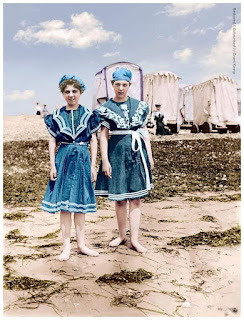It's August 1900, and these two young Victorian ladies stop to pose for an opportunist beach photographer before heading to the bracing sea off Worthing, West Sussex.
It's August 1900, and these two young Victorian ladies stop to pose for an opportunist beach photographer before heading to the bracing sea off Worthing, West Sussex.
These were the last days of the Victorian era, the bathing machines are now parked further up the beach, and mostly used as changing rooms. However, just a few years earlier, and these canvas covered contraptions would have trundled up, and down the beach protecting the modesty of every Victorian bather.
This is a recently restored, and colourised image from a south coast collector, and historian that neatly captures that transitional period.
The bathing machine was a device, popular from the 18th century until the early 20th century, to allow people to change out of their usual clothes, change into swimwear, and wade in the ocean at beaches. Bathing machines were roofed and walled wooden carts rolled into the sea. Some had solid wooden walls, others canvas walls over a wooden frame, and commonly walls at the sides and curtained doors at each end.
The bathing machines in use in Margate, Kent, were described by Walley Chamberlain Oulton in 1805 as:
"Four-wheeled carriages, covered with canvas, and having at one end of them an umbrella of the same materials which is let down to the surface of the water, so that the bather descending from the machine by a few steps is concealed from the public view, whereby the most refined female is enabled to enjoy the advantages of the sea with the strictest delicacy."
Once in the water, the occupants disembarked from the sea side down steps into the water. Many machines had doors front and back; those with only one door would be backed into the sea or need to be turned around. It was considered essential that the machine blocked any view of the bather from the shore. Some machines were equipped with a canvas tent lowered from the seaside door, sometimes capable of being lowered to the water, giving the bather greater privacy. Some resorts employed a dipper, a strong person of the same sex who would assist the bather in and out of the sea. Some dippers were said to push bathers into the water, then yank them out, considered part of the experience.
According to some sources, the bathing machine was developed in 1750 in Margate, Kent. This version was probably intended to conceal the user until they were concealed by being in the water, as bathing costumes were not yet common and most people at the time bathed nude. "Mr. Benjamin Beale, a Quaker, was the inventor of the Bath Machine.
Bathing machines remained in active use on English beaches until the 1890s, when they began to be parked on the beach. They were then used as stationary changing rooms for a number of years. Most of them had disappeared in the United Kingdom by 1914.
This is my colourised version of a black, and white photograph taken on Worthing Beach in 1900, but I have posted the original within the comments.


.jpg)

.jpeg)






Comments
Post a Comment